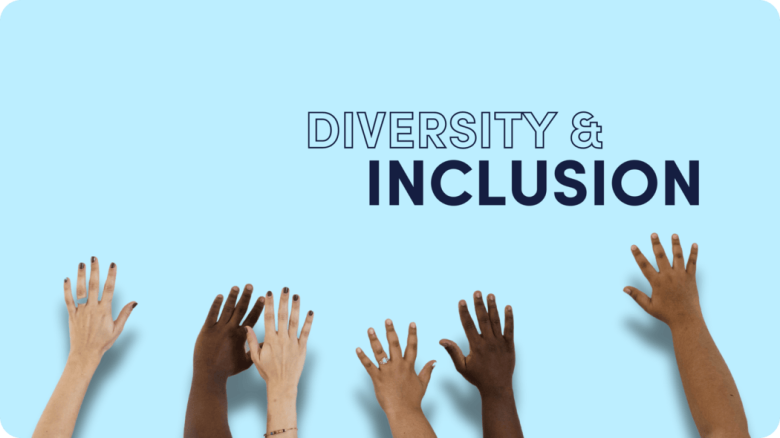While buzzwords like “diversity” and “inclusion” tend to be overused, they form parts of any productive workplace. Welcoming different cultures, views, and experiences in today’s globalized world is extremely important as it brings innovation and creativity, which are fundamental for success. But how do organizations encourage and support inclusivity? What steps do companies take to remove obstacles that resist change?
These are the questions this blog aims to address as it explains why diversity is important and how companies can strategically incorporate policies that promote inclusivity for all members of the organization, regardless of their background. It is time we ask ourselves how we can transform workplaces to represent the beauty and richness of human beings we appreciate.
Understanding Diversity and Inclusion:
Lack of diversity makes inclusion difficult and vice versa – the two are closely knit concepts. The presence and representation of people of different races, ethnicities, genders, ages, religions, sexual orientations, or disabilities in a particular setting refers to Diversity, the first step towards having a functioning diverse workforce. It enables us to focus on the various groups that make up a single unit. Inclusion means creating a space where all people are made to feel accepted. This is beyond simply ‘having’ different identities and perspectives; they are welcomed, heard, or taken seriously and treated respectfully.
A workplace that promotes inclusion alongside effective collaboration among people of different cultures, genders, and races is truly diverse. This form of synergy often results in novel approaches to solving problems as well as better problem-solving skills in general. Culturally, understanding the difference between discrimination and diversity involves recognizing the value of everyone’s interaction. Inclusion, on the other hand, is about blocking every form of discrimination as well as allowing for constructive conversations. Together, both concepts form the basis of equity, which helps everyone, as well as the organization.
Lessons On Embracing Inclusion and Workplace Diversity:
Even though it may seem that diversity and inclusion are just phrases to be used in a modern marketing approach, they are key ingredients to any meaningful workplace. Fostering innovation is only possible with a team composed of people with different experiences, skills, and creative ideas, all under the umbrella of a properly valued inclusiveness policy. Such policies guarantee each team member respect and value. In addition, when the employees feel they have a space in which their voices matter, company-wide engagement improves dramatically. Employees become more active participants in discussions, and ideas abound.
Companies that adopt such ways of working tend to have higher employee satisfaction and even retention rates. There is so much more than just the legal contract they sign; such brands are beloved and nurtured by their staff members. Furthermore, when companies take care of specially marginalized inclusivity groups, they can understand their customer base much better. These are people who take comfort in services tailored to meet their demographic. Such opportunities create healthy competition in the global market, enabling everyone to perform irrespective of their ethnicity, gender, or nationality. It is so clear that the numbers don’t tell it all; it is even better for the whole company’s culture.
Common Obstacles to Diversifying and Including:
Advancing diversity and inclusion (D&I) strategies comes with a fight, and it is not easy. One that stands out is the unconscious bias that comes with the place of work. Employees tend to assume that a candidate will be a cultural fit because they went to the same school or grew up in the same neighborhood. The other bias that comes with D&I is that people hate change. It is known that some companies operate under archaic mindsets that pose a challenge to the employment of new thinking styles. These two kinds of bias can bring some form of innovation stagnation, something diversity is meant to solve.
These issues are further complicated by a lack of funding. Smaller firms, for example, may not be able to afford training sessions or inclusion marketing campaigns. Furthermore, employees tend to put in minimal effort when there is no visible commitment from top executives. D&I, in the absence of diversity-friendly institutional structures, active support, and consistent slogans from the leadership, is almost futile and ineffective. Without funding and a strong readiness from the leadership, the company culture will struggle to develop.
Building Ethics While Advancing Inclusion and Diversity Policies:
Creating and developing ethics around D&I requires careful crafting. One practical means is to have policies around standings and communication that emphasize change. Use marketing staff for various roles in upper-level management to avoid biases where an individual’s background dictates their role. Business leaders must obtain knowledge relevant to the backgrounds of participants, such as through Black History Month workshops.
Form employee resource groups that cater to different identities within the workplace. These groups provide employees with safe spaces for discussion, networking, and mentorship. Implement accountability metrics into your diversity initiatives. A steady evaluation of progress will assist in goal achievement while allowing for flexibility throughout the process. Incorporate active leadership support for inclusion efforts. With every intentional inclusive action taken by leadership, organizational adoption of such behaviors follows and creates a ripple effect across the company.
Diversity and Inclusion Initiatives That Were Done Effectively:
There are many companies making moves to incorporate diversity and inclusion initiatives, and the results are remarkable. Take the example of Starbucks and its ‘Race Together’ campaign aimed to foster race conversations in their stores. This campaign stimulated discussions among both employees and customers. Meanwhile, Salesforce enacted a proactive measure in the tech world by conducting a company-wide equal pay audit. Their commitment to address any gender and ethnic wage gaps within the company headlined this initiative. This approach improved company morale and increased the allure of the company amongst potential employees.
Unilever offers another exemplary case. Their “Diversity at Every Level” program seeks to improve representation for women and people of color in underrepresented groups at all levels, particularly in leadership roles. Through active support and specific goals, they work towards inclusiveness that appreciates different viewpoints and fosters belonging. This case demonstrates how organizations are willing to make an effort in diversifying the workforce for the positive impact it creates for employees and the organization.
Developing an Equitable Workplace Culture:
Establishing a culture of fairness begins with fostering open dialogue. Encourage employees to share opinions and concerns without repercussions. This openness builds trust and inclusiveness. Clear policies protecting individuals from discrimination must be embedded in the organization, and everyone must be briefed on the policies and their ramifications. Ongoing diversity training can act as reinforcement toward respecting each other as team members on the staff.
Celebrating diversity within an organization fuels motivation and underscores the power of such inclusion. Celebrate the achievements whose sources come from different backgrounds. Support without recognition is unproductive. Equity should not only be a concept that gender management speaks about; practices that demonstrate equity should be visible at all managerial levels, even when it comes to key decisions. Unbalanced justice will create a positive tone and set up a context where all staff feel inspired to contribute.
Conclusion:
Encouraging diligence in the workplace is obtained from inclusivity where everyone feels valued. Ethically grounded strategies instate respect, which often results in innovative business outcomes.
Promoting inclusivity boosts business growth alongside its diversity. Every emerging business should start gradual change with Open dialogues and continued education. No single effort will be enough, but every bit moves toward eradicating inequality in the workforce. A workplace that prioritizes equal opportunity supports the idea of nurturing synergy and expansion for everyone in the organization, regardless of rank.
FAQs:
1. What is the difference between inclusion and diversity?
Inclusion and diversity are terms most people think go hand in hand together, however this is n,ot the case. Inclusion is aimed at providing equal opportunity, whereas diversity focuses on the present culture wwith regardto eethnicity gender, age, sexual orientation o r even isability disabilityon.
2. In what ways could small businesses foster greater diversity within their company?
Small businesses can make a difference by reaching out to diverse demographics for active recruitment and providing training on subconscious bias. Fostering candid dialogue on topics of diversity is also beneficial.
3. How do leaders contribute to the greater diversity within the workforce?
The culture in an organization is usually determined by its leaders. Ideally, they need to promote and support diversity policies and explain how they will measure their success.
4. Is there any legislation related to the diversity of employees within a workplace?
Yes. Most jurisdictions have laws that aim to control discrimination based on factors like ethnicity or sex. Such laws are intended to control discrimination, but going deeper allows true inclusiveness.
5. What actions would help the employees become more active in changing the workplace inclusively?
Employees can challenge biased actions they witness and discriminatory practices and even mentor or work with people from different backgrounds.




